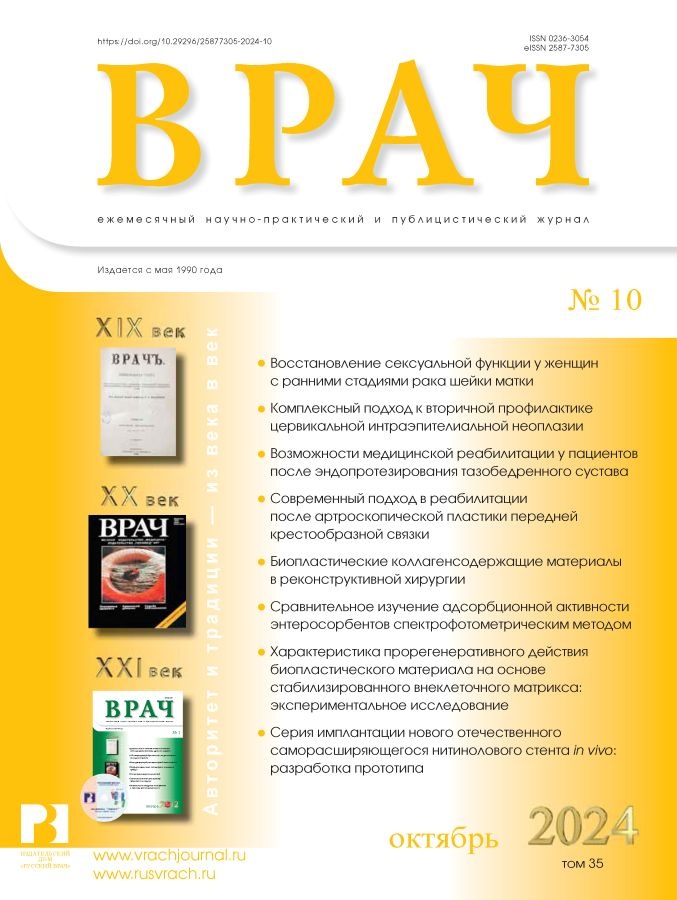Series of implantation of a new domestic self-expanding nitinol stent in vivo: prototype development
- Authors: Verkhovskaya E.V.1, Vanyurkin A.G.1, Panteleeva Y.K.1, Poplavsky E.O.1, Tsvetkova E.V.1, Samuilovskaya S.A.1, Kogay S.V.1, Evdokimov A.S.2, Evdokimov S.V.2, Chernyavsky M.A.1
-
Affiliations:
- Almazov National Medical Research Center
- MedEng Research and Production Enterprise
- Issue: Vol 35, No 10 (2024)
- Pages: 84-90
- Section: From Practice
- URL: https://journals.eco-vector.com/0236-3054/article/view/689580
- DOI: https://doi.org/10.29296/25877305-2024-10-20
- ID: 689580
Cite item
Abstract
Objective. To determine the characteristics of the prototype of a new domestic self-expanding nitinol stent for the treatment of peripheral arterial disease, based on the results of computer mathematical modeling.
Material and methods. 3 domestic pigs were selected to carry out a series of implantation of a domestic self-expanding nitinol stent with an oversizing of 5–20% into the common iliac artery. Vital signs were assessed in all pigs throughout the observation period. After 3 months, the animals underwent control angiography and ultrasound examination of the iliofemoral segment, followed by withdrawal from the experiment by euthanasia. The next step was a morphological analysis of the stented areas of the vessels. The design of experimental samples was carried out using the finite element method and software for computer 3D modeling Orobix, v.1.3.
Results. Throughout the entire observation period (3 months), vital signs in all animals remained within normal values. Control angiography and ultrasound examination after 3 months demonstrated patency and the absence of significant restenoses in all pigs. Morphological analysis showed no signs of damage to the vessel walls. Using computer mathematical modeling, we determined the optimal oversizing values (1,2 < OS < 1,4) and a reference sample of the designed device was determined.
Conclusion. The samples of the nitinol stent passed preclinical animal tests and showed the safety of their use. A qualitatively new structure of the stent for peripheral arteries with a corrugated ring of variable pitch was designed.
Full Text
About the authors
E. V. Verkhovskaya
Almazov National Medical Research Center
Author for correspondence.
Email: verkhovskayakatya@gmail.com
Russian Federation, Saint Petersburg
A. G. Vanyurkin
Almazov National Medical Research Center
Email: verkhovskayakatya@gmail.com
Russian Federation, Saint Petersburg
Yu. K. Panteleeva
Almazov National Medical Research Center
Email: verkhovskayakatya@gmail.com
Russian Federation, Saint Petersburg
E. O. Poplavsky
Almazov National Medical Research Center
Email: verkhovskayakatya@gmail.com
Russian Federation, Saint Petersburg
E. V. Tsvetkova
Almazov National Medical Research Center
Email: verkhovskayakatya@gmail.com
Russian Federation, Saint Petersburg
S. A. Samuilovskaya
Almazov National Medical Research Center
Email: verkhovskayakatya@gmail.com
Russian Federation, Saint Petersburg
S. V. Kogay
Almazov National Medical Research Center
Email: verkhovskayakatya@gmail.com
Russian Federation, Saint Petersburg
A. S. Evdokimov
MedEng Research and Production Enterprise
Email: verkhovskayakatya@gmail.com
Candidate of Engineering Sciences
Russian Federation, PenzaS. V. Evdokimov
MedEng Research and Production Enterprise
Email: verkhovskayakatya@gmail.com
Candidate of Engineering Sciences
Russian Federation, PenzaM. A. Chernyavsky
Almazov National Medical Research Center
Email: verkhovskayakatya@gmail.com
MD
Russian Federation, Saint PetersburgReferences
- Writing Committee Members; Gornik H.L., Aronow H.D., Goodney P.P. et al. 2024 ACC/AHA/AACVPR/APMA/ABC/SCAI/SVM/SVN/SVS/SIR/VESS Guideline for the Management of Lower Extremity Peripheral Artery Disease: A Report of the American College of Cardiology/American Heart Association Joint Committee on Clinical Practice Guidelines. J Am Coll Cardiol. 2024; 83 (24): 2497–604. doi: 10.1016/j.jacc.2024.02.013
- Tang Q.H., Chen J., Hu C.F. et al. Comparison Between Endovascular and Open Surgery for the Treatment of Peripheral Artery Diseases: A Meta-Analysis. Ann Vasc Surg. 2020; 62: 484–95. doi: 10.1016/j.avsg.2019.06.039
- Jeshari S., Die Loucou J., Leboffe M. et al. Preoperative Sizing to Lower In-Stent Restenosis in Peripheral Arterial Occlusive Disease. Ann Vasc Surg. 2024; 106: 37–50. doi: 10.1016/j.avsg.2024.02.017
- Zhao H.Q., Nikanorov A., Virmani R. et al. Late stent expansion and neointimal proliferation of oversized Nitinol stents in peripheral arteries. Cardiovasc Intervent Radiol. 2009; 32 (4): 720–6. doi: 10.1007/s00270-009-9601-z
- Duda S.H., Bosiers M., Lammer J. et al. Drug-eluting and bare nitinol stents for the treatment of atherosclerotic lesions in the superficial femoral artery: long-term results from the SIROCCO trial. J Endovasc Ther. 2006; 13 (6): 701–10. doi: 10.1583/05-1704.1
- Saguner A.M., Traupe T., Räber L. et al. Oversizing and restenosis with self-expanding stents in iliofemoral arteries. Cardiovasc Intervent Radiol. 2012; 35 (4): 906–13. doi: 10.1007/s00270-011-0275-y
- Bernini M., Colombo M., Dunlop C. et al. Oversizing of self-expanding Nitinol vascular stents – A biomechanical investigation in the superficial femoral artery. J Mech Behav Biomed Mater. 2022; 132: 105259. doi: 10.1016/j.jmbbm.2022.105259
- Ascher E., Hingorani A.P., Marks N. et al. Predictive factors of femoropopliteal patency after suboptimal duplex-guided balloon angioplasty and stenting: is recoil a bad sign? Vascular. 2008; 16 (5): 263–8. doi: 10.2310/6670.2008.00091
Supplementary files

















